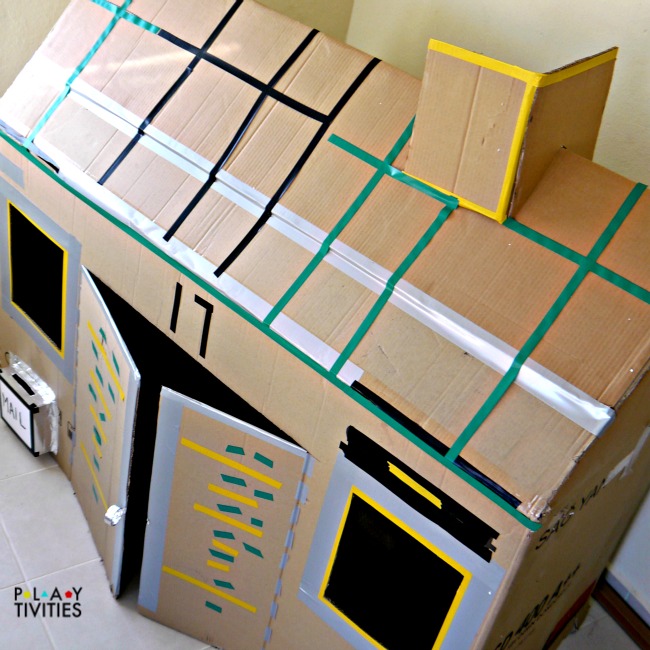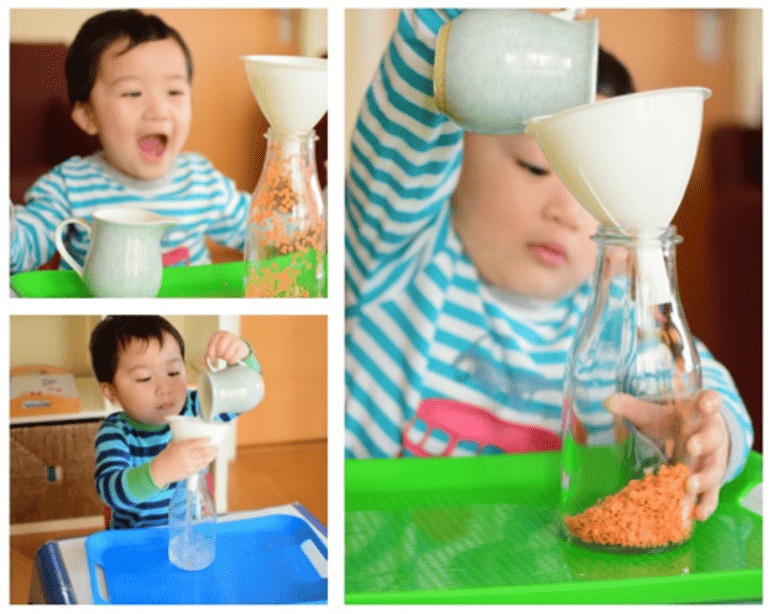
Ever wondered why your child lines up cars, organize toy food by color, and becomes obsessed with throwing and hiding objects? These are all parts of a child development theory called play schemas (trajectory, transporting, rotation, connecting, enclosing, enveloping, orientation, positioning, and transforming). Childhood schemas are important for brain development and understanding how things work, but how can we support this important cognitive development in their learning space? It’s hard to think up different types of activities, so check out the ideas listed below to learn more!
1. Paper Airplanes (Trajectory Schema)

If your child throws food from their highchair or toys out of their pram, making paper airplanes is a great way to meet this need for trajectory input and is super fun for kids, all you need is a piece of paper!
Learn More: Engineering Emily
2. Hill Rolling (Rotation Schema)

A fantastic activity for children who spin around repeatedly to regulate their bodies. If this sounds like your child, find a gentle hill or slope and let them roll on the grass.
Learn More: Rhythms of Play – Hill Rolling for Good Health
3. Wrap Up the Doll in Scarves (Enveloping Schema)

Children can enjoy hiding things and wrapping up objects; a normal developmental process is called enveloping. Introduce some play scarves and let them wrap up their dolls or teddies. Children will love the feel of the different fabrics.
Learn More: Kid Activities with Alexa
4. Cardboard Box Forts (Enclosing Schema)

Creative activities are super effective at making sure play schemas are being worked on. Simply making a cardboard box house is perfect if your little one enjoys hiding or covering themselves.
Learn More: Playtivities
5. Sweep the Pom Poms (Transporting Schema)
Pushing and pulling objects is an important skill to develop. It’s great for gross motor skills too. Grab an old broom and have them sweep pom poms into a “goal”. Super fun for little helpers!
Learn More: Living Montessori Now
6. Playing Skittles (Trajectory Schema)

Your child has discovered knocking things over; whether it’s their food bowl or their friend’s building block creation. This activity focuses their attention in a way that is fun and engaging, and all you need is a yoga mat, pool noodles, and some chip cans! The object is to knock over the cans.
Learn More: HGTV
7. Make Sock Puppets (Enveloping Schema)

Children love puppets and by making their own sock puppet they can create their own character and bring it to life! Pull out an old pair of socks, some glue, and googly eyes, and have fun creating!
Learn More: Mas and Pas
8. Create Paddocks for Animals Using Blocks (Enclosing Schema)

If your little one is drawing circles or boxes around objects or building walls, you could encourage further development of the enclosing schema by having them create paddocks for their farm animals.
Learn More: Teaching Ideas
9. Stone Mountains (Positioning Schema)
A great activity for outdoors and it can be enjoyed both at the beach or in your garden! All you need are some stones and a steady hand! Balance the stones on top of each other to make a stone mountain, but be careful, it’s harder than it looks! Great for fine motor skill development.
Learn More: Building Stone Towers at the Beach
10. Sofa Cushion Obstacle Course (Trajectory Schema)
A perfect rainy-day activity that’s great for restless little ones. If your child is exploring, jumping, and climbing, building their own obstacle course will support their trajectory development. Add to the experience by adding books and blankets!
Learn More: Bethany N
11. Hula Hooping (Rotation Schema)
Grab some hula hoops and head outdoors. This activity is perfect for children who are spinning, twirling, and twisting. The rotating schema involves working on balance and coordination and is great for developing spacial awareness.
Learn More: Cape Town Kids Centre
12. Order Objects According to Material, Size, or Shape (Positioning Schema)

Children work through the positioning schema by lining up construction toys, animals, and blocks. If this sounds like your child, this simple sticker activity will meet their needs perfectly!
Learn More: Busy Toddler
13. Pushing Objects into Play-Doh (Trajectory Schema)

If you have stencils or cookie cutters, great! If not, don’t worry. Use household objects in a range of different shapes (pencils, blocks, construction toys) or head outside for some sticks and leaves to experiment with.
Learn More: Busy Toddler
14. Bubbly Whisks (Rotation Schema)

Children who are fascinated with spinning and twisting love this. Simply add some bubble mixture to a large cup of water and let them whisk and play with the bubbles. Add drops of food coloring to color the water for added fun!
Learn More: Emma Owl
15. Use Funnels and Cups for Bath Play (Transporting Schema)

Bath time is an excellent time for play and learning about how things work. Introducing some funnels and cups to bath time is great for a child’s brain development. Encourage them to move cups of water from one cup to another and fill larger containers.
Learn More: Pinay Home Schooler
16. Stacking Cups (Connecting Schema)
https://www.youtube.com/watch?v=nDnzRIJwa3U
Connection schemas (stacking, building, and making links) are great ways for children to learn about how things fit together; crucial for developing early math and science skills. This simple connection activity is useful for children who are exploring joining, building, and stacking and really works those fine motor skills.
Learn More: Four Seasons Notebook
17. Ice Melting (Transforming Schema)
Children are fascinated by ice. Simply add some ice and salt to a tray and add a few drops of food coloring, the colors will then mix making beautiful patterns. Great for children who are changing things, mixing colors, and wetting sand.
Learn More: Teach Me by Storypark
18. Jumping through Hoops (Trajectory Schema)

Burn off energy by channeling their play to support the trajectory schema. Jumping through hoops teaches children balance and coordination and is great for gross motor skill development. This simple activity is fun and perfect for little climbers and swingers!
Learn More: SSWW
19. Moon Sand (Transforming Schema)

Make your own moon sand with your child; exploring different textures and scents to create different shapes. Add in some tools to help with those fine motor skills! Pay careful attention to the way the sand changes shape, and discuss with your child what it reminds them of.
Learn More: Happy Mothering
20. Pram or Trolley Play (Transporting Schema)

Does your little one push a baby doll in a pram or trolley? This is a really common schema for children. Add a purpose for their trip by giving them goal-orientated tasks; “Can you use your trolley to move these balls to the ball pool?” This gives them a sense of responsibility.
Learn More: Thanet Early Years Project






